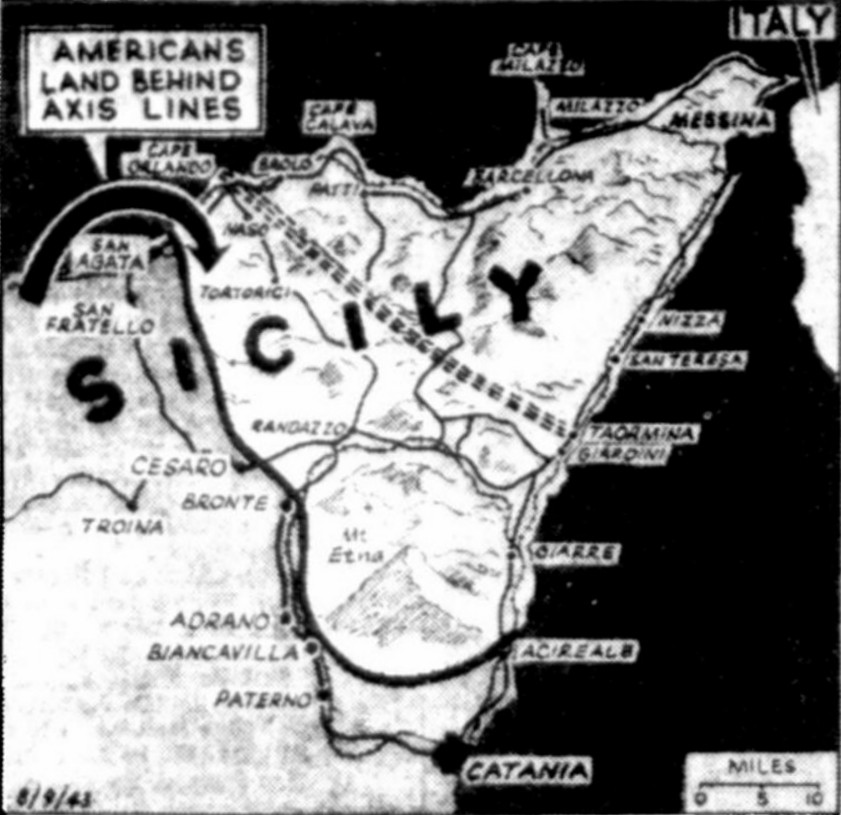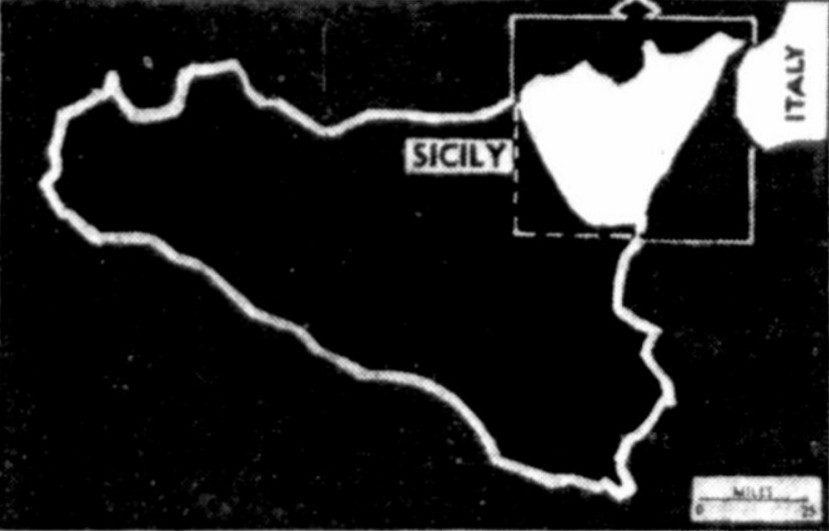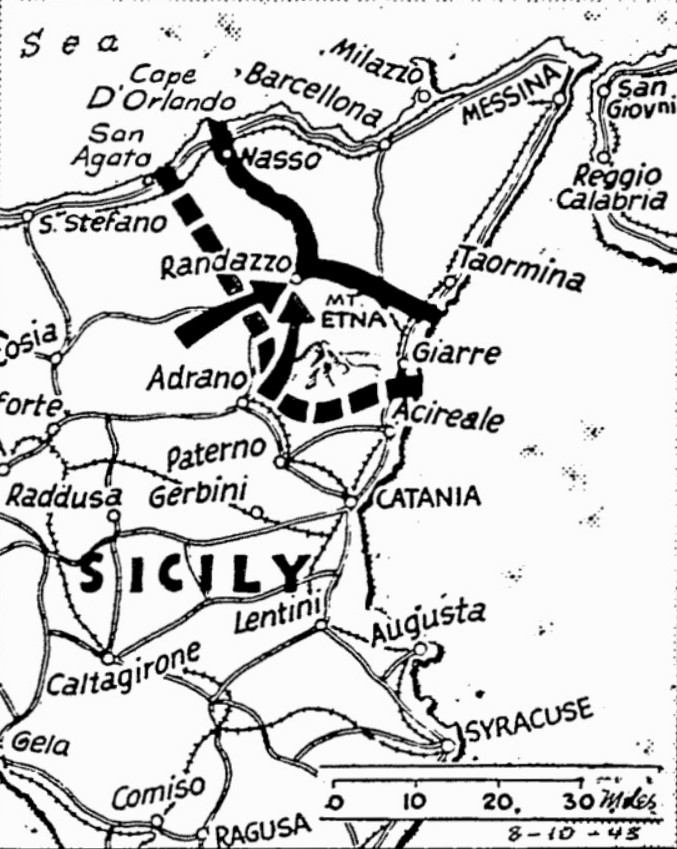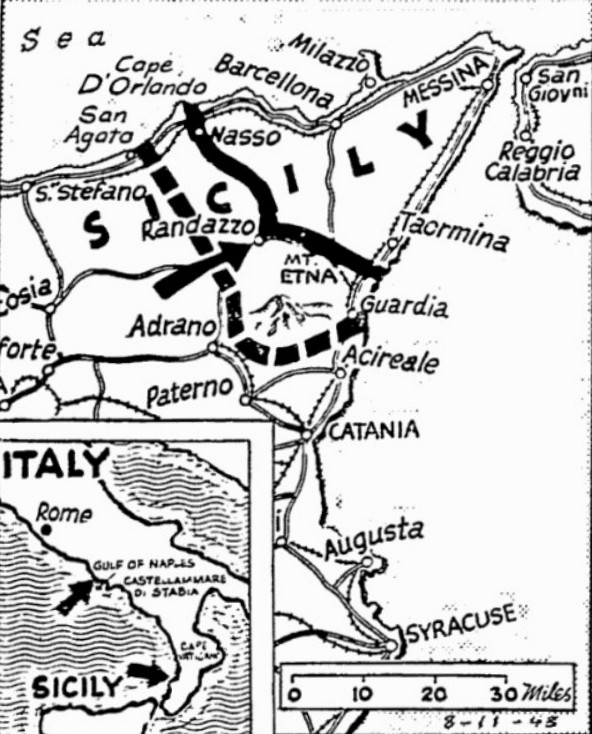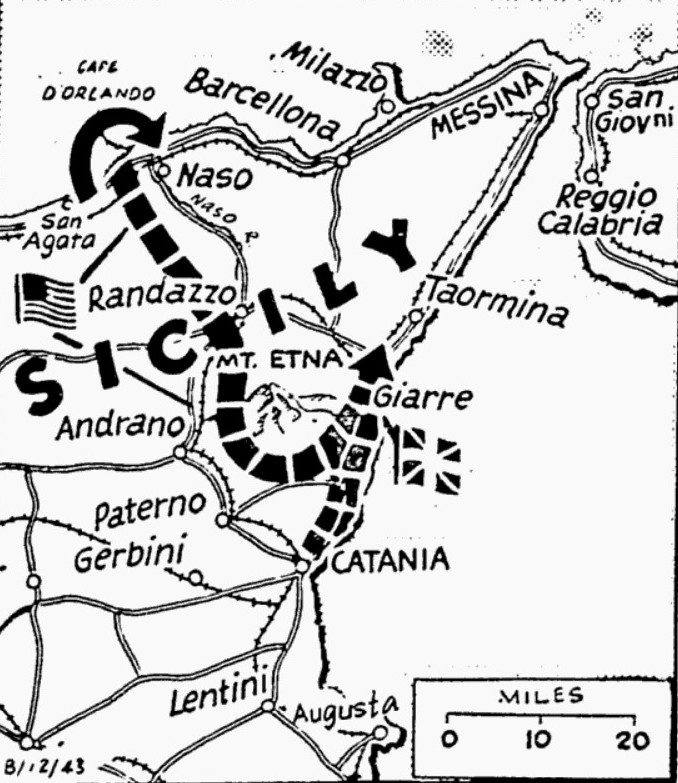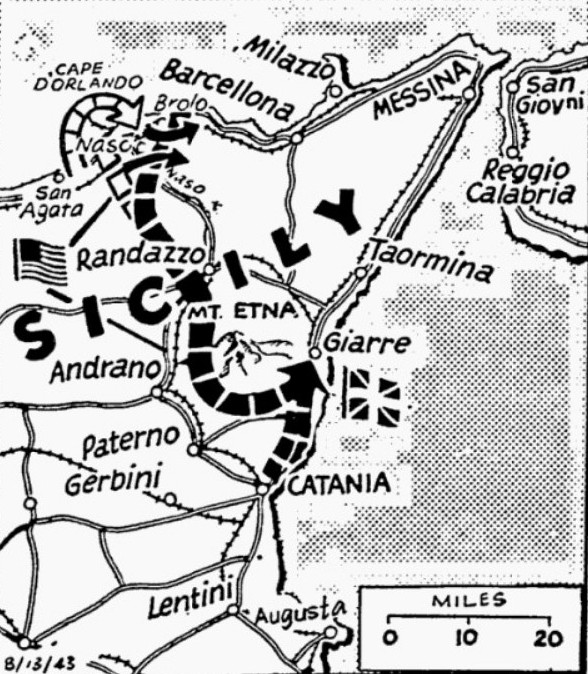The Pittsburgh Press (August 9, 1943)
Patton lands troops behind German lines
Nazi defenses unhinged by spectacular feat of Americans
By Virgil Pinkley, United Press staff writer
Surprise maneuver by U.S. forces pushed the fighting front nearer Messina as U.S. troops landed behind the Axis lines on the north coast of Sicily (arrow). Other Allied gains included capture of Sant’Agata on the north coast, San Fratello, Cesarò and Acireale. The Germans were expected to shorten their defenses to a line running from Capo d’Orlando to Taormina. The lower map shows the tiny portion of Sicily left in Axis hands.
Allied HQ, North Africa –
A spectacular American landing behind the German line on the north coast of Sicily unhinged the Axis defenses and sent them rocking back today toward positions roughly 30 miles from road’s end at Messina.
Allied armies in general advanced all around the tottering defense arc across northeastern Sicily, seized the towns of Sant’Agata, San Fratello, Cesarò and Acireale, consolidated their hold on one-half of the base at Mt. Etna, and pursued German troops in headlong flight from the closing jaws of a pincer aimed at Randazzo Pass.
Battered German forces were reported struggling to form a new defense line angling from the Capo d’Orlando area on the north coast to Taormina on the southeast.
Behind Nazi lines
Lt. Gen. George S. Patton Jr. added a dash of the sensational to the methodical crushing of the last Axis resistance in Sicily by sending one of his 7th Army units wheeling around the north end of the German line for a dawn landing.
Small barges and other landing craft stole through the coastal waters under cover of darkness, swarmed ashore on a split-second schedule, rounded up 300 prisoners, and joined their comrades driving eastward along the coastal road through Sant’Agata.
The Sunday morning landing threw the whole German setup behind the coastal flank into a state of confusion bordering on panic. Enemy reinforcements which were pushing cautiously down the highway were routed. As the motorized transports turned tail, confused knots of traffic made easy pickings for the Americans gathering up prisoners.
Amphibious landings
United Press correspondent C. R. Cunningham in a dispatch from Sant’Agata today said that landing craft carrying men and tanks and other smaller Allied vessels kept a rendezvous with cruisers and destroyers before striking for a beach miles behind the enemy frontline.
The landing craft dumped U.S. soldiers on the beach marked by exploding artillery shells and then put to sea again quickly.
The amphibious landings were executed by veterans who had crashed onto the beaches at Fedala on the Moroccan coast last Nov. 8.
It had been planned originally to make the landing behind the Germans at San Stefano, 16 miles west of Sant’Agata, but this raid was called off by Lt. Gen. Omar Bradley as untimely. Then it was reset for Friday night to squeeze out the Sant’Agata-San Fratello anchor, but again Gen. Bradley called it off because a German reconnaissance plane had spotted the landing craft getting ready and had bombed a tank-landing craft.
Landing is perfect
The early morning landing on Sunday was perfect in every detail.
The landing vessels hit the beaches on the dot and the doughboys swarmed ashore, meeting no resistance. They caught some 200 Germans sleeping.
The Americans cut the road and chopped up a motor convoy heading westward to aid in the defense of San Fratello. Three Axis tanks eluded the invading force and headed into a trap to the west where they were knocked out later. Two of the tanks were German Mark IVs and the other was an Italian M35.
Other enemy tanks fled eastward in confusion, only to be chased along the road and fired upon by Allied destroyers. The toll of tanks was not determined at once.
Yanks push ahead
Other 7th Army units advanced seven miles as the crow flies but actually 14 as the serpentine roadway winds up from captured Troina to take the strategic town Cesarò, midway between Troina and Randazzo.
At Cesarò, the Americans were only 12 miles from Randazzo – site of a narrow defile toward which the retreating Germans were scrambling – and the British at Bronte were about eight miles distant.
The British 8th Army, in one of its best days of the entire Sicilian campaign, pushed ahead to take the port of Acireale, town of 29,000 which is the most important highway center between Catania and Taormina.
Nazis pulling out
The British line curving around northwestward now embraced more than one-half of the base of Mt. Etna, the towering volcano which has a base of 90 miles in circumference.
The German effort to form the new defense line between Capo d’Orlando and Taormina meant that, under cover of fierce rearguard action in some sectors, the Nazis were pulling out altogether from the Caronian Mountains and even from the strategic slopes of Mt. Etna.
The new line was being drawn up with a long-shot hope of holding the highway just behind it, the last north-south road of any consequence still in Axis hands.
Strong units of the Hermann Göring Division had shifted up to the northern sector to strengthen the German 29th Motorized Division which opposed the U.S. 7th Army.
The Northwest African Air Force kept a protective umbrella over northeastern Sicily and southern Italy, bombing highways, bridges, railroads and shipping while fighters poured cannon and machine-gun fire into every kind of targets.
An Italian communiqué broadcast by the Rome radio said bitter fighting continued in the northern sector of the Sicilian front. Off the island, the communiqué said, German planes scored bomb hits on two destroyers. Allied naval bombardments and air raids on coastal cities in Sicily and southern Italy were reported, but the communiqué said they had no “great consequences.”
With the capture of Cesarò, the Allies squeezed the Axis escape corridor below Randazzo Pass to eight miles and brought the fleeing German columns under savage cross-artillery fire.
Italians face trap
Military observers in London said the 7th and 8th Armies were closing in rapidly on Randazzo and threatening to trap substantial forces, but warned that a hard fight could be expected before it can be captured.
Roads from Randazzo to the north coast were reported yesterday by Allied airmen to be completely blocked with jammed traffic. The fliers added to the havoc with bombing and strafing attacks.
